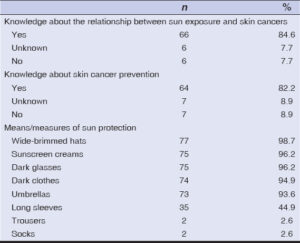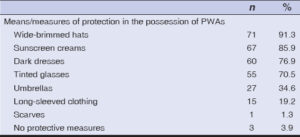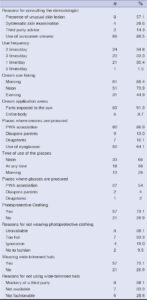Knowledge, attitudes, and practices of people with albinism about photoprotection and skin cancer prevention in Togo
Abla Sefako Akakpo 1*, Julienne Noude Téclessou2, Ablavi Ahoefa Oyenitiwa Adani-Ife3, Saliou Adam4, Panawe Kassang1, Gountaanthe Logte Sanwogou5, Piham Gnossike6, Reine-Pélagie Gligbe1, Garba Mahamadou1, Abas Mouhari-Touré7, Koussake Kombaté2, Kissem Tchangai-Walla1, Palokinam Pitché1, Bayaki Saka1
1*, Julienne Noude Téclessou2, Ablavi Ahoefa Oyenitiwa Adani-Ife3, Saliou Adam4, Panawe Kassang1, Gountaanthe Logte Sanwogou5, Piham Gnossike6, Reine-Pélagie Gligbe1, Garba Mahamadou1, Abas Mouhari-Touré7, Koussake Kombaté2, Kissem Tchangai-Walla1, Palokinam Pitché1, Bayaki Saka1
1Dermatology and STI Department, CHU Sylvanus Olympio, University of Lomé, Togo, 2Dermatology and STI Department, CHU Campus, University of Lomé, Togo, 3Medical Oncology Department, CHU Sylvanus Olympio, University of Lomé, Togo, 4Maxillofacial Surgery Department, CHU Sylvanus Olympio, University of Lomé, Togo, 5Elavagnon Prefectural Department, East-Mono, Togo, 6Gbossimé Dermatology Centre, Lomé, Togo, 7Dermatology and STI Department, CHU Kara, University of Kara, Togo
Citation tools:
Copyright information
© Our Dermatology Online 2024. No commercial re-use. See rights and permissions. Published by Our Dermatology Online.
ABSTRACT
Objective: The aim of this study was to evaluate the knowledge, attitudes, and practices of people with albinism (PWAs) related to photoprotection and prevention of skin cancers in Togo.
Materials and Method: A qualitative, cross-sectional study was conducted over a period of three months in the year 2020 among PWAs over eighteen years of age residing in Lomé, Togo.
Results: A total of 78 PWAs were interviewed. Their mean age was 23.38 ± 15.11 years (extremes: 18 and 63 years), and their sex ratio (M/F) was 0.81. In terms of knowledge, all PWAs declared that photoprotection was essential to prevent skin cancers. Interview data revealed the following strengths: wearing a wide-brimmed hat (n = 77; 98.7%) and using sunscreen cream (n = 75; 96.2%) were the main means/measures of prevention. In terms of attitudes, only 27 PWAs (34.6%) said that a dermatology consultation would be their first reaction to an unusual skin lesion. The main prevention means/measures in their possession were wide-brimmed hats (91.3%), sunscreen creams (85.9%), dark clothes (76.9%), and tinted glasses (70.5%). Regarding the practices, sunscreen creams were used by 88.5% of PWAs (n = 69). About two-thirds (64.1%) of respondents used tinted glasses to protect themselves from the sun. Finally, less than a quarter of the respondents (17.9%) consulted a dermatologist for a skin lesion in the last twelve months.
Conclusion: The results of this study indicated that PWAs in Togo have fairly good knowledge about photoprotection and prevention of skin cancers. Attitudes and practices were generally positive but some behaviors such as dermatological follow-up still require improvement.
Key words: Albinism, Sun protection, Skin cancers, Togo
INTRODUCTION
Oculocutaneous albinism (OCA) is a group of hereditary conditions linked to gene defects in melanin biosynthesis [1]. The absence or reduction of melanin in the skin in albinism is associated with increased sensitivity to UV radiation and predisposition to skin cancers [1,2]. Carcinomas are by far the most common histological variety [3], and most develop by the age of 20–30 years. The risk for people with albinism (PWA) in Africa to develop skin cancers is one thousand times higher than in the general population [4]. Skin photoprotection refers to all natural and/or artificial measures aimed at limiting the skin’s exposure to UV rays, in order to protect it from deleterious effects. These measures are essentially individual behaviors recommended to all PWAs in order to prevent skin cancers [5].
In Togo, PWAs are grouped together under the National Association of PWAs (ANAT), which currently has over 500 members [6], for a general population of 8.443 million in 2020 [7]. To our knowledge, no study has been conducted in Togo to highlight the knowledge, attitudes, and practices (KAP) of PWAs about photoprotection and prevention of skin cancers. It was, therefore, necessary to conduct this study to evaluate the knowledge, attitudes, and practices of PWAs related to photoprotection and prevention of skin cancers in Togo in 2020.
MATERIALS AND METHODS
A qualitative, cross-sectional study was conducted over a three-month period from March to May 2020 among PWAs who are members of ANAT and residing in Lomé, Togo. The sample was exhaustive. All PWAs aged 18 years or older seen at the time of the consultation and having given their consent to participate in the study were included. For data collection, we employed a pre-established form. The data collected was sociodemographic (age, sex), knowledge about photoprotection, a link between skin cancers and sun exposure, means/measures of preventing skin cancers, a notion of dermatology consultation in the last twelve months, reasons for appointments at the hospital or the association’s head office, the use of sunscreen creams or their lack, sunglasses, and information tools on albinism.
Ethics Statement
The study was approved by the Bioethics Committee for Health Research (Reference N°015/2019/CBRS). Previous agreement of PWAs was obtained. Informed consent was obtained from the participants before the questionnaires were filled out. The purpose of the study was explained to them.
RESULTS
A total of 78 PWAs, with a mean age of 23.38 ± 15.11 years (extremes: 18 and 63 years) and a sex ratio (M/F) of 0.81 were interviewed. Among these, 73 (93.6%) belonged to PWA’s association. Among the 78 PWAs, 27 (34.6%) received a health education manual on albinism, with ANAT as the main donor. PWAs’ sources of information on albinism were PWA associations (51.3%), health professionals (33.3%), the Internet (19.2%), parents (12.8%), books (12.8%), and radio (2.6%). A PWA may have one or more sources of information.
In terms of knowledge, all PWAs reported that photoprotection was essential to prevent skin cancers. Among them, 84.6% (n = 66) affirmed that there was a risk of skin cancers linked to sun exposure. Sun-exposed occupations (n = 74; 94.9%) were the occupations most commonly considered not recommended to PWAs. Sixty-two PWAs (79.5%) claimed to have been talked to/informed/aware of skin cancers and 64 (82.2%) attested that it was possible to avoid them (Table 1). Among the means/measures of prevention, PWAs mainly mentioned wearing wide-brimmed hats (n = 77; 98.7%) and using sunscreen (n = 75; 96.2%) (Table 1).
In terms of attitudes, only 27 (34.6%) said that a dermatology consultation would be their first reaction to an unusual lesion on their skin. The main means of prevention in their possession were wide-brimmed hats (91.3%), sunscreen creams (85.9%), dark clothing (76.9%), and tinted glasses (70.5%) (Table 2).
Regarding the practices, less than a quarter of the PWAs (n = 14; 17.9%) consulted a dermatologist in the last twelve months. The presence of skin lesions was the most frequently mentioned reason for this consultation (n = 8; 57.1%). Sunscreen creams were used by 88.5% (n = 69) of PWAs, mainly in the morning (88.4%). About two-thirds (64.1%) of the PWAs used sunglasses to protect themselves from the sun, especially at midday (66%) (Table 3).
DISCUSSION
The main strength of our study was related to the relatively large number of PWAs included. Its main limitation was related to the fact that it was limited to PWAs residing in Lomé (urban area) and, therefore, concerned only one-fifth of PWAs in Togo. Furthermore, rural patients with albinism may have a different rate of awareness of photoprotection, which deserves further study.
The results of this study indicated that PWAs have fairly good knowledge about photoprotection and prevention of skin cancers. Furthermore, attitudes and practices were generally positive. The mean age of our PWAs was 23.38 years, comparable to that found by Madubuko et al. in Benin [8] and by Inena et al. in the Democratic Republic of Congo (DRC) [9], who found a mean age of 24.1 and 26.5 years, respectively. In contrast, Picard et al. [10] in France reported a mean age of 43.98 years, probably due to life expectancy (PWAs in Africa die earlier of skin cancers) and because of the difficulty of access to care for many). A health education manual on albinism was received by 34.6% of our surveyed PWAs, and the main sources of information on albinism were a PWA association, health professionals, and the Internet. Ouédraogo et al. [11] showed that the main source of information for their PWAs was health professionals (65.6%). We noted that these sources are diverse and that the main ones are PWA associations, organizations, and health professionals. In addition, the WHO, having recognized albinism as an important public health issue in sub-Saharan Africa, also established the INTERSUN Programme, which provides information on the harmful effects of UV radiation and may, therefore, serve as the main basic communication tool for raising awareness [12,13].
All our PWAs declared that photoprotection was essential, as did those in the study by Ouédraogo et al. [11] in Burkina Faso. The majority of our respondents (n = 66; 84.6%) affirmed that there was a link between sun exposure and skin cancers and that it was possible to prevent it through sun avoidance. Ouédraogo et al. [11] also mentioned a strong link between sun exposure and the risk of developing skin cancer in 91.5% of their PWAs. This unanimity may be explained by the fact that both surveys were conducted in associations of PWAs who are regularly told about the dangers of sun exposure for their skin and, therefore, the need for photoprotection. Chu et al. [14] in Botswana found that PWAs strongly believed that skin cancers were preventable and treatable in 94% and 74% of cases, respectively, and that sunscreen could prevent them (77%). Furthermore, among the 78 PWAs, 79.5% had been talked to/informed/aware about skin cancers. This result was comparable to that in the study by Ouédraogo et al. [11], in which 68.3% of the PWAs said they had already been screened for skin cancer because of the sensitization.
Regarding attitudes, the main means/measures of prevention in possession of our PWAs were wide-brimmed hats (91.3%) and sunscreen creams (85.9%). Only 34.6% of the PWAs stated that a dermatology consultation would be their first reaction to an unusual lesion on their skin. Among the respondents in the study by Ouédraogo et al. [11], 42.7% stated that systematic screening every three months by a dermatologist was also a practical attitude to adopt. Although the PWAs in these different studies used photoprotection methods, a minority systematically consulted a dermatologist, who should normally be the one to coordinate and direct their multidisciplinary management in general and particularly the detection of precancerous lesions [15]. This shows the inadequacy of awareness of systematic screening for skin cancer. The creation of a dermatological hospital dedicated to PWAs and discussion groups may be strategies to improve self-referral of patients to dermatologists for the diagnosis of lesions or routine skin examinations.
In terms of practices, sunscreen creams were used by 88.5% of our PWAs. In Malawi, Gilaberte et al. [16] noted 80% using sunscreen. About two-thirds (64.1%) of the respondents in our study used sunglasses to protect themselves from the sun. Ouédraogo et al. [11] reported that the primary means of prevention were sun avoidance, the use of sunscreen creams, and the use of protective clothing in 84%, 41.5%, and 51.2% of the PWAs, respectively. In Botswana [14], 88% of PWAs applied sunscreen to their face and photo-exposed areas and 94% wore sun-protective clothing such as wide-brimmed hats and long-sleeved shirts (92%). Thus, the adoption of full protective clothing (long sleeves and wide-brimmed hats) increased from 80–90% to 99–100% in Malawi [16].
CONCLUSION
This study showed a fairly good notion of sun avoidance as the main means/measures of preventing skin cancers in PWAs in Lomé, Togo. Furthermore, attitudes and practices toward photoprotection and prevention of skin cancer were generally positive, yet some behaviors such as dermatological follow-up still require improvement because only a quarter of them have regular dermatological follow-up. Continued awareness of photoprotection is essential to minimize the occurrence of skin cancer in this vulnerable population, even if it does not always translate into behavior.
ACKNOWLEDGMENTS
We would like to thank the Pierre Fabre Foundation for fully funding this dermatological consultation project for PWAs in Togo. We also thank the National Association of PWAs of Togo (ANAT) for coordinating the PWA consultation campaigns in Togo.
Statement of Human and Animal Rights
All the procedures followed were in accordance with the ethical standards of the responsible committee on human experimentation (institutional and national) and with the 2008 revision of the Declaration of Helsinki of 1975.
Statement of Informed Consent
Informed consent for participation in this study was obtained from all patients.
REFERENCES
1. Aquaron R. Human albinism:Clinical, genetic, cellular, biochemical and molecular aspects. Med Trop Rev Corps Sante Colon. 2000;60:331 41.
2. Bonniol JL. Black skin:An anthropologist’s journey between biology and sociology. Ann Dermatol Venereol. 2006;133:853-8.
3. Bulliard J-L, Panizzon RG, Levi F. Epidemiology of epithelial skin cancers. Rev Med Suisse. 2009;5:884 8.
4. Wright CY, Norval M, Hertle RW. Oculocutaneous albinism in sub-Saharan Africa:Adverse sun-associated health effects and photoprotection. Photochem Photobiol. 2015;91:27 32.
5. Fontaine J, Mielczarek S, Meaume S, Senet P. [Incidence of undiagnosed skin cancers in a geriatric hospital]. Ann Dermatol Venereol. 2008;135:651-5.
6. Association Nationale des personnes atteintes d’Albinisme au Togo (ANAT) [Internet]. [Cited on 5 december 2021]. Acessed on https://anattogo.org
7. Démographie du Togo [Internet]. [Cited 1st March 2023]. Acessed on https://fr.wikipedia.org/wiki/D%C3%A9mographie_du_Togo.
8. Madubuko CR, Onunu AN. Sun-protection strategies amongst people living with Albinism in Benin-city, Southern Nigeria. Res J Health Sci. 2021;9:245 53.
9. Inena G, Chu B, Falay D, Limengo B, Matondo I, Bokanga A, et al. Patterns of skin cancer and treatment outcomes for patients with albinism at Kisangani Clinic, Democratic Republic of Congo. Int J Dermatol. 2020;59:1125 31.
10. Picard FM, Taieb C, Marti A, Gliksohn A, Gene R, Bodemer C, et al. Fardeau de l’albinisme:création d’un questionnaire. Ann Dermatol Venereol. 2017;144:S236 7.
11. Ouédraogo S, Zongo N, Korsaga-SoméN, KaboréSMS, OuangréE, Zida M, et al. Survey on the knowledge, attitudes, primary prevention practices and screening of skin cancers in Albinos in Burkina Faso. J Cancer Ther. 2016;7:812-23.
12. World Heatlth Organisation. Intersun Programmme. World Health Organization. Available at:http://www.who.int/uv. Accessed July 1, 2010.
13. Wright CY, Jean du Preez D, Millar DA, Norval M. The epidemiology of skin cancer and public health strategies for its prevention in southern Africa. Int J Environ Res Public Health. 2020;17:1017.
14. Chu B, Maranga A, Mosojane KI, Allen-Taylor L, Ralethaka M, Ngubula JC. Sociodemographic features of a cohort of people living with albinism in Botswana. JAAD Int. 2021;2:153-63.
15. Moreno-Artero E, Morice-Picard F, Bremond-Gignac D, Drumare-Bouvet I, Duncombe-Poulet C, Leclerc-Mercier S. et al. Management of albinism:French guidelines for diagnostic and care. J Eur Acad Deramatol Venereol. 2021;35:1449-59.
16. Gilaberte Y, Mzumara TE, Manjolo SP, Kaseko N, Bagazgoitia L, Fuller LC, et al. Evaluation of the acceptance and efficacy of a bespoke sun protection package for persons with oculocutaneous albinism living in Malawi. Int J Dermatol. 2022;61:352-60.
Notes
Request permissions
If you wish to reuse any or all of this article please use the e-mail (brzezoo77@yahoo.com) to contact with publisher.
| Related Articles | Search Authors in |
|
 http://orcid.org/0000-0002-5844-0856 http://orcid.org/0000-0002-5844-0856 http://orcid.org/0000-0003-2619-8396 http://orcid.org/0000-0003-2619-8396 http://orcid.org/0000-0002-9667-5947 http://orcid.org/0000-0002-9667-5947 http://orcid.org/0000-0001-9687-6928 http://orcid.org/0000-0001-9687-6928 http://orcid.org/ 0000-0003-1407-3107 http://orcid.org/ 0000-0003-1407-3107 http://orcid.org/0000-0001-8645-1176 http://orcid.org/0000-0001-8645-1176 http://orcid.org/0009-0006-1029-2555 http://orcid.org/0009-0006-1029-2555 http://orcid.org/0000-0002-8889-2693 http://orcid.org/0000-0002-8889-2693 |







Comments are closed.